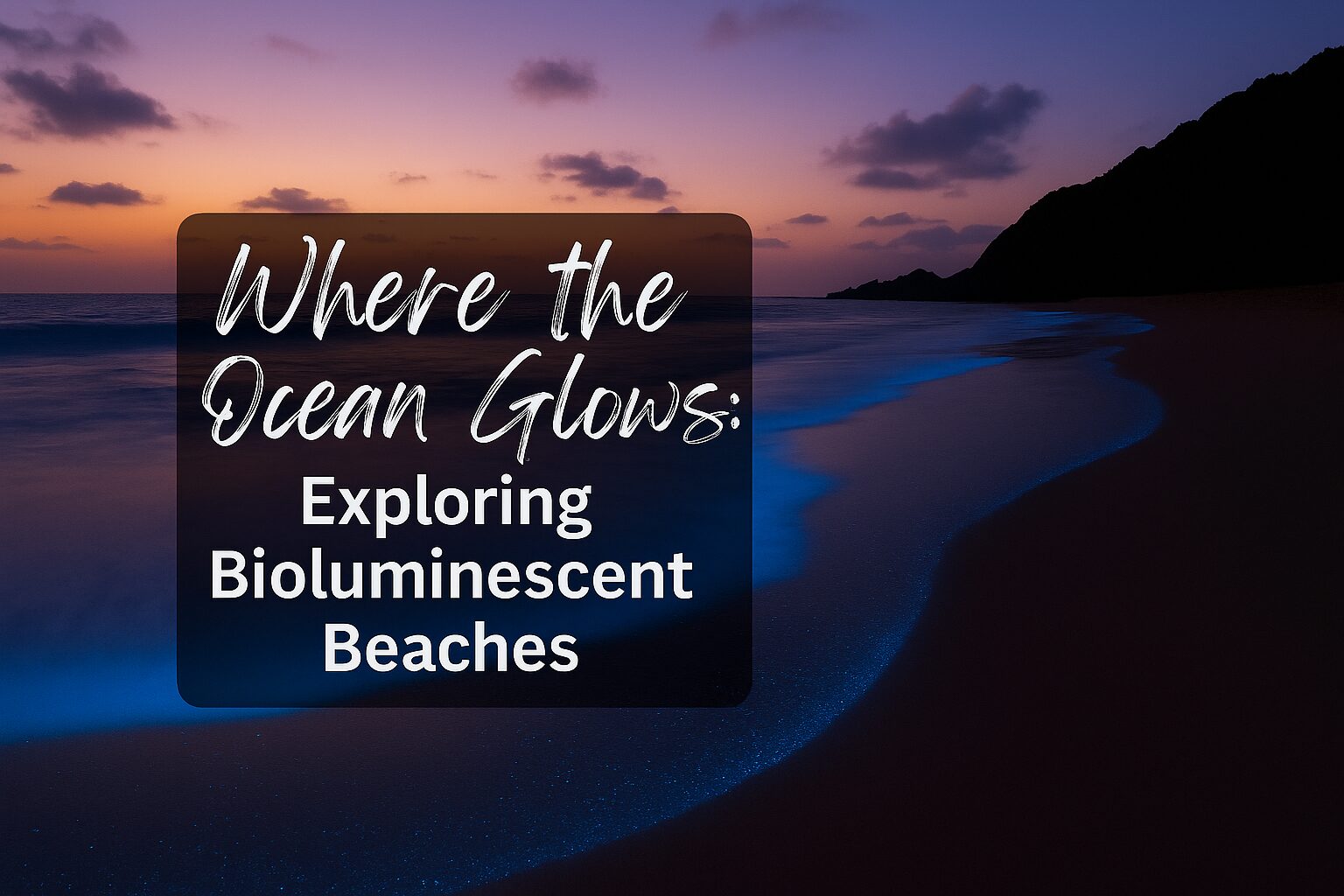Imagine strolling along a beach at night, each wave leaving glowing blue footprints beneath your feet. This enchanting natural phenomenon, known as bioluminescence, captivates travelers worldwide. From remote bioluminescent beaches to glowing oceans under starry skies, witnessing this magic is bucket-list material. But before you plan your next beach trip, it’s essential to understand bioluminescence safety, where to find the best spots, and how to enjoy them responsibly. In this guide, we’ll cover everything from safety tips to top destinations—without sacrificing the awe.
What Is Bioluminescence?
- Bioluminescence, sometimes spelled bioluminescense or bioluminecence, is light produced by living organisms such as plankton and algae.
- These tiny creatures emit light when disturbed—by waves, swimming, or footfalls—creating a glowing ocean effect.
- The result? Ethereal blue waves and bioluminescent water that seems straight out of a fantasy.
Why Beaches Glow: The Science Behind the Magic
This luminous spectacle often involves bioluminescent dinoflagellates or plankton that emit light through a chemical reaction triggered by movement in the water. Some tips to remember:
- Red tides: Not all glowing water is harmless; some bioluminescent organism blooms carry toxins—check local advisories before visiting.
- Sensitive ecology: Touching the water excessively can disrupt fragile ecosystems and stress bioluminescent organisms.
- Seasonal & weather factors: Light shows are best on dark, calm nights with minimal moonlight and human activity.
Is It Safe? Water Bioluminescence Safety Tips
Visiting glowing beaches is generally safe, but a few precautions make your experience worry-free:
- Monitor local alerts
- Some bioluminescent bays may coincide with harmful algal blooms—swimming might be unsafe.
- Bring proper footwear
- Beach terrain can be slippery or rocky at night. Wear water shoes and bring a flashlight—even for glowing water, visibility is low.
- Leave nature untouched
- Avoid disturbing organisms, stepping on coral, or using chemicals like sunscreen in the water.
- Beware of marine life
- Jellyfish and other creatures may be out at night—stay alert and avoid swimming in new areas.
Top Global Bioluminescent Beach Destinations
| Location | Notable Features | Things to Know |
|---|---|---|
| Puerto Rico Bays (Mosquito Bay, Vieques) | World-famous blue-glow, guided kayak tours | Booking is required; eco-friendly tours only |
| Maldives | Glowing beach near Vaadhoo Island | Best observed during dry season |
| San Diego | Periodic glowing waves along southern California beaches | Rare, linked to algal blooms |
| California coast | Occasional bioluminescent beach California shows | Check SoCal bloom reports for updates |
| Florida & Bahamas | Bio bay beach and Bahamas blue hole experiences | Weather-dependent, avoid red-tide periods |
Lesser-Known Gems & Blue Hole Highlights
Besides beaches, luminous regions and sinkholes offer unique views:
- Blue Hole (Wimberley, TX) & Blue Hole Regional Park Wimberley Texas – Edging quiet rivers with occasional nighttime glow
- Soddy Daisy, TN Blue Hole – Scenic natural pool with potential bioluminescent plankton
- Blue Hole Dahab (Egypt), Blue Hole Georgetown TX, and remote Andros Island blue hole offer dazzling turquoise sinkholes
- Puerto Rico luminous lagoon in Fajardo offers night kayaking through glowing waves
Tips to Experience the Glow to Its Fullest
- Plan for moonless nights
- New moon periods maximize visibility of glowing effects.
- New moon periods maximize visibility of glowing effects.
- Hire knowledgeable guides
- Local experts can point out safe, sustainable options.
- Local experts can point out safe, sustainable options.
- Stay still
- Swim gently to gently coax light from plankton, rather than splashing wildly.
- Swim gently to gently coax light from plankton, rather than splashing wildly.
- Protect camera gear
- Use low-light or night settings; handheld stabilization is key.
- Use low-light or night settings; handheld stabilization is key.
- Respect local ecosystems
- Stay on paths, carry out trash, and avoid damaging corals or vegetation.
Safety & Environmental Responsibility
- Bioluminescent beach near me? Search for local marine advisories first.
- Always wear a bioluminescent water safe sunscreen or skip it completely.
- Geo-tourism etiquette: One glowing beach should show just how small footprints matter.
FAQs on Bioluminescence Water & Travel Safety
- Can you swim in glowing water? Yes, but only in areas cleared of toxic algal blooms. Always verify before swimming.
- Why does cocoa beach glow at night? Though not always bioluminescent, sargassum seaweed and plankton can produce faint glows—check reports.
- Is bioluminescent water safe for kids? Generally yes, if the water is confirmed non-toxic—but stick to shallow, controlled zones with supervision.
Responsible Travel & Ethical Tourism
- Support local businesses that practice sustainable tourism.
- Choose small-group kayak tours or beach clean-ups to give back.
- Avoid lighting fires or disrupting sand dunes—ecosystem health is crucial.
Final Thoughts
Bioluminescent beaches pull at our imaginations, blending science with magic under the moon. But to savor that natural spectacle safely, you must plan with care: verify water safety, follow bioluminescence travel safety tips, and respect fragile ecosystems.
Whether you’re chasing glow in the dark beach adventures in Puerto Rico, seeking a glowing ocean plunge in the Maldives, or kayaking through a luminous lagoon at night, treat the experience as both wondrous and weighty.
By blending curiosity with conservation, you can make unforgettable memories while protecting one of Earth’s most captivating natural wonders. In doing so, you embody The Inspiring Insight, balancing wonder with stewardship—and leaving no trace but glowing footprints.




